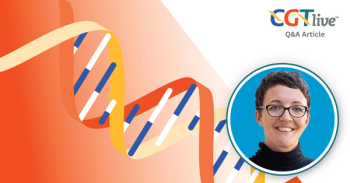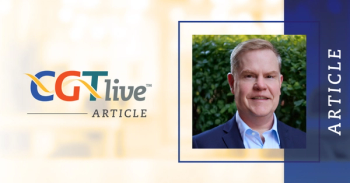
Novel Approaches to Cell Therapy May be Necessary to Tackle Non–Small Cell Lung Cancer
Ben Creelan, MD, a medical oncologist at Moffitt Cancer Center, discussed several different approaches to cell therapy that could lead to new treatment options in the field.
Although relatively simple chimeric antigen receptor T-cell (CAR-T) constructs, such as CD19-directed CAR-T therapies, have been sufficient to address some hematological malignancies effectively, the jump to using CAR-T in solid tumors will almost certainly require a different approach. Currently, a number of companies and institutions are attempting to address issues like off-tumor, on-target toxicity through a variety of methods.
CGTLive™ spoke to Ben Creelan, MD, a medical oncologist at Moffitt Cancer Center who specializes in the treatment of lung cancer and in oncology cell therapy research, to learn more about several of the methods currently in the works across the field. He emphasized that although some of these modalities have been primarily tested in other solid tumor types, the same or similar constructs could potentially be effective in non–small cell lung cancer (NSCLC).
CGTLive: Are there any specific investigational cell therapies for NSCLC currently in development you’re keeping an eye on?
Ben Creelan, MD: I'd say that there are 3 particularly promising approaches, which I can go over very quickly. The first one, which we have the most data for right now in lung cancer, is tumor infiltrating lymphocytes (TIL) [therapy] and we know from a phase 3 trial now that in melanoma, we see these progression free survival plateaus going out past 2 years; patients don't have progression of disease when treated with TIL in this phase 3 trial with melanoma.
So in lung cancer, we have this big plateau envy. We really are saying “how come we're not seeing those kind of survival plateaus?” So, we've been testing TIL in lung cancer. Here at Moffitt, we did a phase 1 trial showing that several patients were able to achieve some durable remissions. The response rate was around 20 to 25%. Iovance Pharmaceuticals did a trial in the third-line setting for routine lung cancer patients and showed a response rate around 21%. The durability of that was questionable because the majority of those patients that initially had a response were progressing within 6 to 12 months. But there's been a more recent press release in the second-line setting specifically—a more pure, cleaner trial by Iovance—showing response rates of at least 26%. That press release also said that the median duration of response wasn't even reached. So, there is some promise here that we can beat docetaxel or standard second-line chemotherapy using cell therapy; we have that potential in lung cancer.
A more sophisticated approach in some ways would be to target a specific antigen, a specific marker on the cell surface, which has always been our problem in solid tumors. That is our glass ceiling that we have to break through: What is the tumor marker that we can target with specificity, with potency, and without also targeting normal tissue cells. We're starting to see some inroads there already in the past couple years. Gradually the carpet is fraying in at the edges because there's a lot of different markers and several of them are showing promise. In lung cancer specifically, we see these markers expressed at low levels. For example, with DLL3 we're seeing great activity using bispecific T-cell engagers. In small cell lung cancer [we are seeing] response rates of 40% or higher and very durable responses going out to a year for medium duration of response. That is just now starting. [Notably], there are neuroendocrine NSCLCs that express DLL3. Neuroendocrine lung cancer is by far the most aggressive cancer that we see in clinic, so the bar for FDA-approval is going to be very low for DLL3.
Next, we have claudin CAR T-cells, which are quite exciting: claudin-18.2 and claudin-6. We are not seeing very much off-tumor, on-target toxicity with these agents, but we are seeing a fair number of response rates. We saw data presented by BioNTech at
Do you have any thoughts on A2 Bio’s A2B530 program and its potential?
I spoke earlier about CAR T-cells and TCR targets that weren't showing much off-tumor, on-target toxicity because they don't seem to be expressed much in normal tissue. Those targets could include DLL3, STEAP2 (which I didn't previously mention, but is also an interesting target),PRAME, claudin-6, claudin-18, and others.
The other way of doing this is to have either an on-on requirement or an on-off requirement on your T-cell: a logic-gate. By having a second signal on the T-cell that tells it to turn off in the presence of a normal marker or to only turn on in the presence of 2 abnormal markers, you can enrich your activity of your T-cell to be specific against the tumor and not target normal tissue. So, what we're doing now is we're going back to those old biomarkers that we had CAR T-cells against 10 to 20 years ago, that were showing too much toxicity, and we're introducing new receptors—new switches—that will hopefully make them more specific.
One example of that is the Tmod approach which introduces an off-switch in the presence of a human leukocyte antigen (HLA) marker. HLA-A*02 is a commonly expressed HLA in the Caucasian population. The prevalence may be as high as 50% to 55%. This requires the tumor to have loss of heterozygosity (LOH) which is basically when a tumor loses the expression of the HLA gene. Normal cells have both HLA genes, while tumor cells often have at least one deleted. So if you have a CAR-T, which only is active in the absence of HLA, and only active in the presence of a common tumor antigen, that is a promising approach.
In the case of the
This transcript has been edited for clarity.
Newsletter
Stay at the forefront of cutting-edge science with CGT—your direct line to expert insights, breakthrough data, and real-time coverage of the latest advancements in cell and gene therapy.































